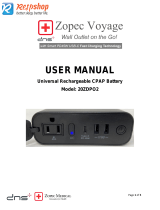
04/22_v3
Smoke Alarms
· Install a smoke alarm outside of each sleeping area and
on each additional level of your home.
· Install smoke alarms INSIDE sleeping areas if people
sleep with their doors closed.
· Test smoke alarms once a month by pressing
test buttons.
· If an alarm fails the test or starts making beeping
noises, replace batteries immediately.
· Replace ALL smoke alarm batteries at least once a year.
Fire Extinguishers
· Consider purchasing one or more fire extinguishers to
keep in your home.
· Read the instructions to understand how your fire
extinguisher works, and make sure all family members
understand how to use it.
· Read the instructions to find out how to check if your
extinguisher is in working order, and how frequently it
needs to be checked.
Escape Ladders
· Consider installing escape ladders for upstairs rooms.
· Learn how to use your escape ladder.
· Store ladders close to windows.
Flashlights
· Keep flashlights throughout your house and make sure
everyone knows where they are located.
· Check batteries regularly.
Escape Routes
· Figure out at least two ways for escaping for every room
in your home.
· Everyone living in your home should be familiar with
these escape routes.
Practice
· At least twice a year, practice using your escape plans.
· Practice crawling because you may need to escape by
crawling under smoke, where the freshest air will be.
Meeting Place
· Decide on a location
where everyone will meet
outside your home after
escaping from a fire.
· A meeting place is
important so that you can
quickly see if everyone
has escaped.
Making Your Escape
· If there is smoke or fire in one escape route, use
another route.
· If there is no way to avoid smoke, remember to stay
low and crawl under the smoke, where the freshest air
will be.
· If you want to escape by opening a closed door, FIRST
check to see if the door feels warm before opening
it. If it is warm, do NOT open the door. Instead, use
another route.
Blocked Escape Routes
If all of your escape routes are blocked by smoke, heat,
or flames:
· Stay in the room and keep any doors closed.
· Keep out smoke by piling rugs, blankets, or pillows
along the bottom of any doors.
· If there is a phone in the room, call 911 and tell them
where you are.
· Signal out a window for help using a brightly colored
cloth, sheet, towel, or flashlight.
· Stay as close to the floor as possible, near a window
or door.
After Escaping
· Go to a neighbor’s house and call 911 as soon
as possible.
· NEVER go back inside a burning house. Once you’re
outside, stay outside!
· When firefighters arrive, tell them if you think anyone is
still inside.
An Ounce of Protection...
Planning Can Prevent Panic
If a Fire Occurs...
SAFETY GUIDELINES
Surviving a Fire in Your Home
Take the time now to prepare — it can save lives!























